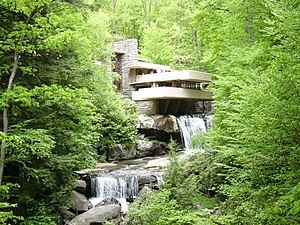Organika arkitekturo

Organika arkitekturo estas filozofio de arkitekturo kiu serĉas harmonion inter homaj loĝejoj kaj la natura mondo pere de dezajnaj alproksimigoj bone integrataj kun sia loko, ke konstruaĵoj, mebloj, kaj ĉirkaŭoj iĝu parto de unuigita, interrilata kompono.
La termino organika arkitekturo estis stampita de la usona arkitekto Frank Lloyd Wright (1867–1959). Organika arkitekturo estas tiele transpasata al inkluda naturo de la dezajnprocezo de Frank Lloyd Wright. Materialoj, motivoj, kaj baza ordoprincipoj plue ripetiĝas tra la konstruaĵo kiel tuto.
Elstaraj organikaj arkitektoj[redakti | redakti fonton]

- Frank Lloyd Wright (1867–1959)
- Alvar Aalto
- Antoni Gaudi
- Hans Scharoun
- Eero Saarinen
- Ivan Taslimson
- Friedensreich Hundertwasser
- Imre Makovecz
Notoj[redakti | redakti fonton]
Bibliografio[redakti | redakti fonton]
- Aldersey-Williams, Hugh (2003). Zoomorphic: New Animal Architecture (London: Laurence King)
- Ferre, Albert, et al., eds (2007). Verb Natures: Architectural Boogazine (Barcelona; New York: Actar)
- Feuerstein, Günther (2002). Biomorphic Architecture: Human and Animal Forms in Architecture (Stuttgart; London: Axel Menges)
- Gans, Deborah, and Zehra Kuz (2003). The Organic Approach to Architecture (New York; Chichester: Wiley)
- Kolarevic, Branko (2000). "Digital Morphogenesis and Computational Architectures", in Proceedings of the 4th Conference of Congreso Iberoamericano de Grafica Digital, SIGRADI 2000 - Construindo (n)o Espaço Digital (Constructing the Digital Space) [ISBN 85-88027-02-X], Rio de Janeiro (Brazil) 25–28 September 2000, ed. by José Ripper Kós, Andréa Pessoa Borde and Diana Rodriguez Barros, pp. 98–103 (http://cumincad.scix.net/data/works/att/4077.content.pdf)
- Leach, Neil (2009). "Digital Morphogenesis", Architectural Design, 79, 1, pp. 32–37
- Menges, Achim (2007). "Computational Morphogenesis: Integral Form Generation and Materialization Processes", in Proceedigns of Em'body'ing Virtual Architecture: The Third International Conference of the Arab Society for Computer Aided Architectural Design (ASCAAD 2007), 28–30 November 2007, Alexandria, Egypt, ed. by Ahmad Okeil, Aghlab Al-Attili and Zaki Mallasi, pp. 725–744 (http://www.ascaad.org/conference/2007/057.PDF)
- Menges, Achim (2006). "Polymorphism", Architectural Design, 76, 2, pp. 78–87
- O'Reilly, Una-May and Martin Hemberg (2007). "Integrating Generative Growth and Evolutionary Computation for Form Exploration", Genetic Programming and Evolvable Machines, 8, 2, pp. 163–186
- Pearson, David (2001). The Breaking Wave: New Organic Architecture (Stroud: Gaia)
- Portoghesi, Paolo (2000). Nature and Architecture, trans. by Erika G. Young (London; Milan: Skira Editore; Thames & Hudson)
- Roudavski, Stanislav (2009). "Towards Morphogenesis in Architecture", International Journal of Architectural Computing, 7, 3, pp. 345–374 (http://www.academia.edu/208933/Towards_Morphogenesis_in_Architecture)
- Steadman, Philip (2008). The Evolution of Designs: Biological Analogy in Architecture and the Applied Arts (New York: Routledge)
- Senosiain, Javier (2003). Bio-architecture (Oxford, England: Architectural Press)
- Tsui, Eugene (1999). Evolutionary Architecture: Nature as a Basis for Design (New York: John Wiley)
Eksteraj ligiloj[redakti | redakti fonton]
- Rudolf Steiner, translated by Harry Collison (1914 publikigita en 1927). Ways to a New Style in Architecture. Rudolf Steiner Archive. Alirita 14a de Februaro 2011.[rompita ligilo]
